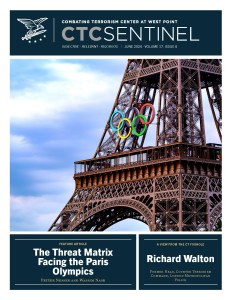From the Director
Beginning in late July, the world’s attention will focus on Paris for the 2024 Summer Olympic Games, followed by the Paralympics. In our cover article, Petter Nesser and Wassim Nasr describe a threat landscape facing the Games that is “diverse and multifaceted” with “both known and predictable terror threats and others that are less likely on paper but hold the potential for surprise.” “Jihadism,” they write, “remains the main non-state terror threat to Western Europe, France, and the Olympics, with Islamic State Khorasan posing a clear and present danger to the Games.”
Richard Walton, former head of the London Metropolitan Police’s Counter Terrorism Command who led its counterterrorism efforts during the 2012 Olympics, offers insights into what security services are facing with the Paris Games. “This will be France’s biggest peacetime security policing challenge,” he surmises. “It will be France’s biggest test of their new intelligence infrastructure since they reviewed it post-2015 after the Paris attacks.” The stakes will be high throughout the entire country for the duration of the Olympics and Paralympics, he notes. “Any attack in France during the Games is an attack on the Games.”
Alexandre Rodde, David Mcilhatton, John Cuddihy, and Rachel Monaghan describe the attractiveness of sports venues as terrorist targets as well as the associated public spaces that support these competitions, such as hotels, restaurants, and public transportation—what they refer to as the events’ “supply chain.” While security at venues is always robust during competitions, they warn that “what is left more exposed is the supply chain to these events. There are simply too many locations and businesses to provide protective security measures at scale … significant importance must be placed on engaging as many of those locations as possible, by providing training for businesses to help them understand the threats they might face, what to do if something does happen, and how to recover.”
Finally, Yannick Veilleux-Lepage examines right-wing extremists’ use of 3D-printed firearms (3DPF). Utilizing an original dataset of 35 incidents worldwide, he investigates “the geographical and temporal spread of 3DPF use by RWE” and outlines several of the main motivations for their use. He finds “a troubling increase in the incidents involving 3DPF across multiple regions, indicating a spread beyond isolated communities into more mainstream adoption among right-wing extremist factions” with the number of cases rising from just one incident in 2017 to 11 in 2023. This data-driven article will serve as an important foundational piece of work upon which other researchers and practitioners can build so that the CT community can better track the evolution of this important and evolving threat area.
Colonel Sean Morrow, Director, Combating Terrorism Center
 Skip to content
Skip to content

